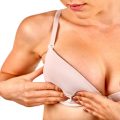The breast is the tissue overlying the chest (pectoral) muscles. Women’s breasts are made of specialized tissue that produces milk (glandular tissue) as well as fatty tissue. There are many different types of breast shapes, and it’s important to remember that every woman’s breasts are unique and normal in their own way. Here are some common breast shapes:
- Round: Round breasts are full and equally sized, with a gentle curve at the top and bottom.
- Teardrop: Teardrop breasts are fuller at the bottom and taper off at the top, with a gentle slope.
- East West: East West breasts point outward, away from the center of the body, with nipples that face to the sides.
- Bell Shape: Bell-shaped breasts are fuller at the bottom and narrower at the top, with nipples that point downward.
- Slender: Slender breasts are long and narrow, with nipples that point downward.
- Asymmetric: Asymmetric breasts have different sizes or shapes. One breast may be larger or have a different shape than the other.
- Athletic: Athletic breasts are firm and muscular, with a smaller size and minimal sag.
- Relaxed: Relaxed breasts have a softer, looser appearance, with nipples that may point downward.
It’s important to remember that breast shape can change over time due to several factors. The amount of fat determines the size of the breast. The medical term for falling or sagging breasts is known as ptosis. Breast changes such as ptosis happen naturally with age. But, many other factors can lead to breasts that droop. Here’s what you need to know about the causes, prevention, and treatment of sagging breasts.
What Can I Do For My Breast to Stand Again?
Before we go into what you can do in order to lift your breast quickly, it is important to understand the factors that contribute to breast sagging and the science behind the fall of the female breasts.
Age: There isn’t a specific age when you can expect your breasts to begin to sag. A woman in her twenties can have droopy breasts, while a woman in her forties can still have perky breasts. Because many things contribute to sagginess, women experience it at different times. Of course, age does eventually become a factor for all women. If you manage to escape drooping in your thirties and forties, you will most likely begin to notice the loss of elasticity and fullness in your breasts as you go through the hormonal changes of menopause.
Several factors can influence the degree to which breasts sag with age, including genetics, weight fluctuations, pregnancy, and breastfeeding. Women with larger breasts may also be more prone to sagging as they age, as the weight of the breasts can put extra strain on the skin and ligaments that support them.
Stretching Ligaments: Ligaments in your breasts, called Cooper’s ligaments, lift and support your breasts. Over time, these ligaments can stretch out and cause the breasts to sag. Loose skin or the loss of skin’s elasticity can also lead to droopy, deflated boobs. Many things can influence when these changes will happen or the degree of drooping that you will experience. Here are some of the causes of saggy breasts.
Weight loss or gain: Gaining or losing a good deal of weight, especially quickly, can change the shape of your breasts and stretch or shrink the skin surrounding them. Gaining or losing weight can also affect breast size. Breasts are made up of fatty tissue, glandular tissue, and connective tissue. When a person gains weight, their breasts may also increase in size as the body stores more fat in the breast tissue. Similarly, when a person loses weight, their breasts may decrease in size as the body burns fat for energy.
However, the amount of weight gain or loss necessary to affect breast size can vary from person to person. Some women may notice a significant change in breast size with just a small amount of weight gain or loss, while others may not see much of a difference at all.
Gravity: Gravity can have an effect on the appearance of the breasts over time. Breasts are composed of glandular tissue and fat, but they are not supported by muscle. Instead, they are supported by ligaments and connective tissue, which can stretch over time due to gravity, age, and other factors. As a woman ages, her breasts may gradually sag or droop due to a loss of elasticity in the ligaments and connective tissue that support the breasts.
Body mass index: BMI, or body mass index, is a measure of body fat based on height and weight. It is a useful tool for assessing a person’s overall health, but it does not directly correlate with breast size. Breast size is determined by a variety of factors, including genetics, hormones, age, and body weight. Some studies have suggested that there may be a correlation between BMI and breast size, with women who have higher BMIs tending to have larger breasts. However, this correlation is not always consistent and may vary depending on a woman’s individual body composition.
Smoking: Smoking can have an impact on breast health in many ways. Firstly, smoking has been linked to an increased risk of breast cancer. Women who smoke are at higher risk of developing breast cancer than non-smokers. This may be because smoking causes changes in the levels of hormones in the body, which can affect the growth of breast cancer cells. Secondly, smoking can cause premature aging and skin damage, which can affect the appearance of the breasts. Smoking can cause the skin to become dry and lose its elasticity, which can cause the breasts to sag and appear less firm.
Genetics: Heredity and the genes you get from your family play a part in the size and shape or your breasts, the strength of your Cooper’s ligaments, and your body weight. Genetics can play a role in determining the overall size of a woman’s breasts, which can indirectly affect their shape. Breast shape is primarily determined by the amount of glandular tissue, fat tissue, and connective tissue present in the breasts, as well as the amount of elasticity in the skin. These factors can be influenced by a variety of factors, including age, weight fluctuations, hormonal changes, and pregnancy. While genes can influence the amount of glandular tissue present in the breasts, which can affect overall breast size, they do not appear to play a significant role in determining breast shape.
Number of pregnancies: The more children you have, the more stretched out your breasts will become. During pregnancy, the breasts grow further due to stimulation by estrogens (female hormones). The growth during pregnancy is more uniform than that observed at puberty. The amount of tissue capable of producing milk is approximately the same in all women, so women with smaller breasts produce the same amount of milk as women with larger breasts. During pregnancy, the areola becomes darker and enlarges in size.
Exercise without support: Exercise that involves a lot of breast movement can put extra strain on the breast ligaments. If the breasts, especially large breasts, do not have proper support, it can lead to stretching of the ligaments and sagging of the breasts. Some exercises that involve repeated bouncing or high-impact movements may lead to temporary breast discomfort or soreness. This is especially true for women with larger breasts, as the bouncing can cause strain on the breast ligaments and lead to discomfort.
Size and Shape: Smaller breasts with a rounder bottom tend to hold their shape better than larger or narrow breasts. Larger breasts are also more likely to succumb to gravity than smaller breasts. This is because the weight of the breast tissue puts a strain on the skin and ligaments that support the breasts, and larger breasts have more weight and volume than smaller breasts.
Can A Fallen Breast Rise Again
Yes, a fallen breast rise again. There are several methods and remedies to use in lifting a falling breast. Some of the sag-reducing and breast-lifting strategies are not new but they still work wonders when adopted strategically. Here is how to make your breast stand firm even after the fall:
Breast Boosting Exercise
Since breasts don’t have muscle, you can’t firm up breast tissue with exercise. However, beneath the breasts are fibrous connective tissue and muscles that can be exercised to improve the overall appearance of your chest. Various chest exercises are recommended to improve not only muscle strength, but posture as well. Regular exercise can also help women maintain a healthy and consistent weight, which can prevent changes in breast shape associated with extreme weight gain and loss. Breast Enlargement Pills and Cream Side Effects
Eating well
There’s no hard evidence linking diet to breast sag. But some health experts believe that eating lots of antioxidant-rich foods (like fruits and vegetables such as broccoli, cabbage, kale, watermelon, and whole grains) can keep skin supple and reduce the appearance of wrinkles and sag from head to toe. Staying hydrated may help preserve the skin’s natural elasticity, as well. Avoid extreme or crash diets, too. Eat more nuts, fish, soybeans, and pumpkin seeds to increase omega-3 fatty acids. In addition, add more avocado and eggs to up the monounsaturated fats to promote breast tissue growth this is one of the simple ways to get a fallen breast to stand firm again.
Wearing a bra
You’d think that wearing a bra would prevent ligaments in the breasts from getting stretched out, which in turn would help retain perkiness. But research doesn’t support this notion: A 2013 French study even suggests that wearing a bra actually encourages sagging by weakening supportive connective tissue in breasts. (The lead researcher described the findings as “preliminary,” however, so take that with a grain of salt.) Sure, wearing a supportive and well-fitting bra will keep your breast propped up while you’re wearing it.
Your sleep position
Sleeping on your side may cause breasts to sag more over time since one will dangle downward and its ligaments can become stretched. (On a related note, side-sleeping can also contribute to facial wrinkles since one side of your face is smushed against the pillow). Snoozing on your back, on the other hand, can help reduce signs of aging and because the weight of your breasts is fully supported on your chest, it may help them retain their perkiness.
Stop Smoking
On top of all the other harmful effects of cigarette smoke, it’s also a breast sag offender. A 2008 study in the Aesthetic Surgery Journal found that women who smoked were more likely to experience breast droopiness after pregnancy. (The study was actually designed to see if breastfeeding had an effect on breast aesthetics and found that, contrary to popular belief, it did not.) Smoking can also cause the collagen in the skin to break down, promoting droop.
Having breast lift surgery
If you’re really unhappy with your breast sag, there is one remedy that doctors say can turn back time: “breast lift” surgery, also called a mastopexy. During a breast lift, plastic surgeons remove excess skin and tighten the surrounding tissue. The surgery has grown in popularity by 70% since 2000, outpacing breast implants 2-to-1. The most common kind of cosmetic surgery is breast augmentation. In 2018, more than 310,000 women and teenagers in the United States underwent surgery to have their breasts enlarged with silicone or saline implants, a number that has more than tripled since 1997, when there were just over 101,000 of these procedures.
In cases where a person is unhappy with the position or appearance of their breasts, they may want to consider speaking with a plastic surgeon to discuss options for breast lift or other cosmetic procedures.





